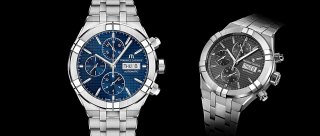Automatic watches are stylish pieces of jewellery, technical masterpieces and status symbols all in one. Wristwatches with a mechanical movement, which receive their energy through a rotor, which is made to vibrate by movement of the arm, inspire people for almost 100 years.
read moreabout Automatikuhren
Automatic watches are watches, which have a mechanical movement and are driven by a rotor. This is made to rotate by movements of the arm or wrist in order to wind up the main driving spring. As a result, energy is continuously produced, making a battery superfluous. The rate deviations of a watch vary depending on manufacture, manufacturer calibration, lifestyle, and wearer habits.
Most automatic watches have a rate deviation of -20/+30 seconds per day. Unfortunately, this must be accepted. If a higher accuracy is desired, watches with chronometer testing are a good choice. Here the watches receive the evaluation certificate COSC, for which they must pass various tests in advance - only then can they call themselves a chronometer. The accuracy may have a maximum of -4/+6 seconds deviation per day and is about 20 times more accurate than a normal automatic watch. The wearer's wearing habits play an important role in counteracting the rate accuracy positively, because an active watch wearer can look forward to a more accurate watch than a "passive" watch wearer.
In addition to accuracy, the power reserve also plays a central role in automatic watches. The power reserve, also known as autonomy, refers to the period of time during which the movement continues to run after it has been moved for the last time. Here, the number of hours varies greatly and is between 32 and 60 hours, depending on the watch.
The longevity of an automatic watch can be considerably improved by preventing strong temperature fluctuations, unnecessary shocks, air pressure fluctuations and water pressure, as well as the frequent wearing of a watch. This has a very positive effect on all parts, especially the movement.
A great advantage of automatic watches is, that they do not require batteries. Furthermore, the manual winding of the mainspring is no longer necessary. Thus a long durability of an automatic watch is guaranteed. The movement should be overhauled after 2-5 years if necessary, in order to ensure the durability further.
Last but not least, it is important to know the difference between quartz and automatic watches. Quartz watches are available on the market in analogue and digital versions. They are electromechanical or fully electronic watches, whose clock generator is an electronic oscillator. Therefore, they usually draw their energy from a battery or from button cells. There are a few exceptions, where mechanical energy is converted into electrical charge via a mechanism and stored in batteries. This is the case, for example, with the Seiko Kinetic line. Quartz clocks are usually referred to as real-time clocks. From this it can be concluded that, in contrast to an automatic watch, a quartz watch is clearly ahead in terms of accuracy and has absolute accuracy without movement of the watch.
Automatic watches are particularly interesting for watch connoisseurs. An eye-catcher is the fluid running second hand. Often the watches are equipped with a glass back, which allows a view of the movement and the moving rotor. The fascination of the mechanics of a watch lies quite clearly with automatic watches!

